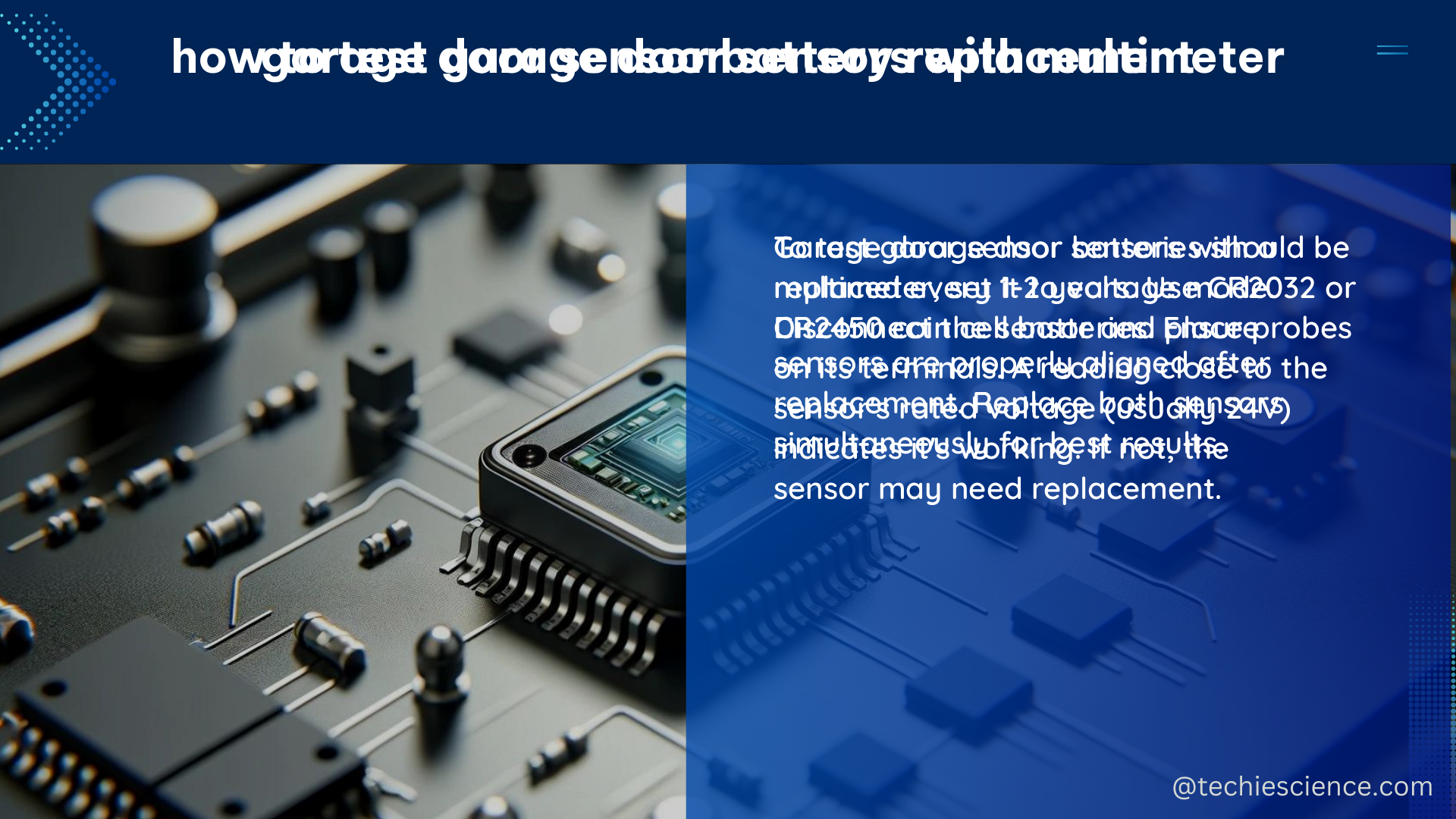Garage door sensors are essential components that ensure the safety and smooth operation of your garage door system. These sensors use infrared beams to detect the presence of objects in the door’s path, preventing the door from closing and potentially causing damage or injury. However, the batteries powering these sensors have a limited lifespan, typically lasting 1-2 years, and need to be replaced regularly to maintain their functionality.
Identifying the Correct Battery Type
The first step in replacing the battery in your garage door sensor is to determine the specific type of battery required. Most garage door sensors use a CR2032 3V lithium coin cell battery, which is widely available and relatively inexpensive. However, it’s essential to consult your garage door manufacturer’s instructions or the sensor itself to confirm the correct battery type.
Battery Specifications
- Battery Type: CR2032 3V lithium coin cell
- Diameter: 20 mm
- Thickness: 3.2 mm
- Voltage: 3V
- Typical Lifespan: 1-2 years
Preparing for the Replacement

Before you begin the replacement process, ensure that you have the necessary tools and materials on hand. You’ll typically need a small flathead or Phillips screwdriver to open the sensor casing and access the battery compartment.
Tools and Materials Needed
- Screwdriver (flathead or Phillips)
- Replacement CR2032 3V lithium coin cell battery
- Soft cloth or paper towel (to avoid fingerprints on the sensor)
Replacing the Battery
-
Locate the Sensor: Identify the garage door sensor that needs a battery replacement. Garage door systems typically have two sensors, one on each side of the door opening.
-
Open the Sensor Casing: Using the appropriate screwdriver, carefully remove the screws or cover to access the battery compartment.
-
Remove the Old Battery: Gently pry out the old battery from the compartment, taking care not to damage the sensor’s internal components.
-
Insert the New Battery: Carefully place the new CR2032 3V lithium coin cell battery into the compartment, ensuring that the positive (+) and negative (-) terminals are aligned correctly.
-
Reassemble the Sensor: Replace the sensor cover and secure it with the screws, ensuring a tight and secure fit.
-
Test the Sensor: After replacing the battery, test the sensor’s functionality by passing your hand through the infrared beam. The sensor should detect the obstruction and prevent the garage door from closing.
Battery Replacement Tips
- Replace Both Sensors: It’s recommended to replace the batteries in both sensors simultaneously to ensure consistent performance and prevent potential safety issues.
- Avoid Touching the Sensor: Try to handle the sensor by the edges or use a soft cloth to avoid leaving fingerprints on the surface, which can interfere with the infrared beam.
- Dispose of Old Batteries Properly: Properly dispose of the old batteries in accordance with local regulations, as they contain materials that can be harmful to the environment.
Maintaining Garage Door Sensor Functionality
Regular battery replacement is crucial for maintaining the proper functioning of your garage door sensors. However, there are additional steps you can take to ensure the long-term reliability of your garage door system:
Sensor Alignment and Cleaning
Periodically check the alignment of your garage door sensors to ensure that the infrared beams are properly aligned. If the sensors are misaligned, the door may not close properly or may reverse unexpectedly. Additionally, clean the sensor lenses with a soft, dry cloth to remove any dust or debris that could interfere with the infrared beam.
Sensor Obstruction Monitoring
Keep an eye out for any objects or obstacles that may be blocking the sensor’s infrared beam. This could include cobwebs, leaves, or other debris that accumulate over time. Regularly inspect the sensor’s path and remove any obstructions to maintain proper functionality.
Professional Maintenance
If you encounter any persistent issues with your garage door sensors, it’s recommended to have a professional garage door technician inspect and service the system. They can diagnose and address any underlying problems, ensuring the safety and reliability of your garage door operation.
By following these comprehensive guidelines, you can effectively replace the batteries in your garage door sensors and maintain the overall functionality of your garage door system. Remember, safety should always be the top priority when working with any garage door components.
Reference:
- “Lessons Learned from Case Studies of Six High-Performance Buildings” – Link
- “ACC II ISOR – California Air Resources Board – CA.gov” – Link
- “Internet of Things For Dummies®, Qorvo 2nd Special Edition” – Link

The lambdageeks.com Core SME Team is a group of experienced subject matter experts from diverse scientific and technical fields including Physics, Chemistry, Technology,Electronics & Electrical Engineering, Automotive, Mechanical Engineering. Our team collaborates to create high-quality, well-researched articles on a wide range of science and technology topics for the lambdageeks.com website.
All Our Senior SME are having more than 7 Years of experience in the respective fields . They are either Working Industry Professionals or assocaited With different Universities. Refer Our Authors Page to get to know About our Core SMEs.